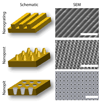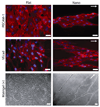Engineering substrate topography at the micro- and nanoscale to control cell function
- PMID: 19492373
- PMCID: PMC2834566
- DOI: 10.1002/anie.200805179
Engineering substrate topography at the micro- and nanoscale to control cell function
Abstract
The interaction of mammalian cells with nanoscale topography has proven to be an important signaling modality in controlling cell function. Naturally occurring nanotopographic structures within the extracellular matrix present surrounding cells with mechanotransductive cues that influence local migration, cell polarization, and other functions. Synthetically nanofabricated topography can also influence cell morphology, alignment, adhesion, migration, proliferation, and cytoskeleton organization. We review the use of in vitro synthetic cell-nanotopography interactions to control cell behavior and influence complex cellular processes, including stem-cell differentiation and tissue organization. Future challenges and opportunities in cell-nanotopography engineering are also discussed, including the elucidation of mechanisms and applications in tissue engineering.
Figures




Similar articles
-
Significance of synthetic nanostructures in dictating cellular response.Nanomedicine. 2005 Mar;1(1):10-21. doi: 10.1016/j.nano.2004.11.008. Nanomedicine. 2005. PMID: 17292053 Review.
-
Micro-scale and meso-scale architectural cues cooperate and compete to direct aligned tissue formation.Biomaterials. 2014 Dec;35(38):10015-24. doi: 10.1016/j.biomaterials.2014.08.047. Epub 2014 Sep 26. Biomaterials. 2014. PMID: 25263687 Free PMC article.
-
Microfabricated nanotopological surfaces for study of adhesion-dependent cell mechanosensitivity.Small. 2013 Jan 14;9(1):81-9. doi: 10.1002/smll.201201098. Epub 2012 Aug 7. Small. 2013. PMID: 22887768 Free PMC article.
-
Interaction of animal cells with ordered nanotopography.IEEE Trans Nanobioscience. 2002 Mar;1(1):24-8. doi: 10.1109/tnb.2002.806918. IEEE Trans Nanobioscience. 2002. PMID: 16689218
-
Cell sensing of physical properties at the nanoscale: Mechanisms and control of cell adhesion and phenotype.Acta Biomater. 2016 Jan;30:26-48. doi: 10.1016/j.actbio.2015.11.027. Epub 2015 Nov 17. Acta Biomater. 2016. PMID: 26596568 Review.
Cited by
-
Nanotopographic cell culture substrate: polymer-demixed nanotextured films under cell culture conditions.Biores Open Access. 2012 Oct;1(5):252-5. doi: 10.1089/biores.2012.0255. Biores Open Access. 2012. PMID: 23515067 Free PMC article.
-
Cell interaction study method using novel 3D silica nanoneedle gradient arrays.Colloids Surf B Biointerfaces. 2013 Feb 1;102:111-6. doi: 10.1016/j.colsurfb.2012.07.044. Epub 2012 Aug 21. Colloids Surf B Biointerfaces. 2013. PMID: 23006558 Free PMC article.
-
Nanopit-induced osteoprogenitor cell differentiation: The effect of nanopit depth.J Tissue Eng. 2016 Jun 2;7:2041731416652778. doi: 10.1177/2041731416652778. eCollection 2016 Jan-Dec. J Tissue Eng. 2016. PMID: 27298716 Free PMC article.
-
Effects of substrate conductivity on cell morphogenesis and proliferation using tailored, atomic layer deposition-grown ZnO thin films.Sci Rep. 2015 Apr 21;5:9974. doi: 10.1038/srep09974. Sci Rep. 2015. PMID: 25897486 Free PMC article.
-
Chemoresistance of Cancer Cells: Requirements of Tumor Microenvironment-mimicking In Vitro Models in Anti-Cancer Drug Development.Theranostics. 2018 Oct 22;8(19):5259-5275. doi: 10.7150/thno.29098. eCollection 2018. Theranostics. 2018. PMID: 30555545 Free PMC article. Review.
References
-
- Goodman SL, Sims PA, Albrecht RM. Biomaterials. 1996;17:2087. - PubMed
-
- Abrams GA, Goodman SL, Nealey PF, Franco M, Murphy CJ. Cell Tissue Res. 2000;299:39. - PubMed
-
- Pamula E, De Cupere V, Dufrene YF, Rouxhet PG. J Colloid Interf Sci. 2004;271:80. - PubMed
-
- Wolf K, Muller R, Borgmann S, Brocker EB, Friedl P. Blood. 2003;102:3262. - PubMed
Publication types
MeSH terms
Grants and funding
LinkOut - more resources
Full Text Sources
Other Literature Sources

